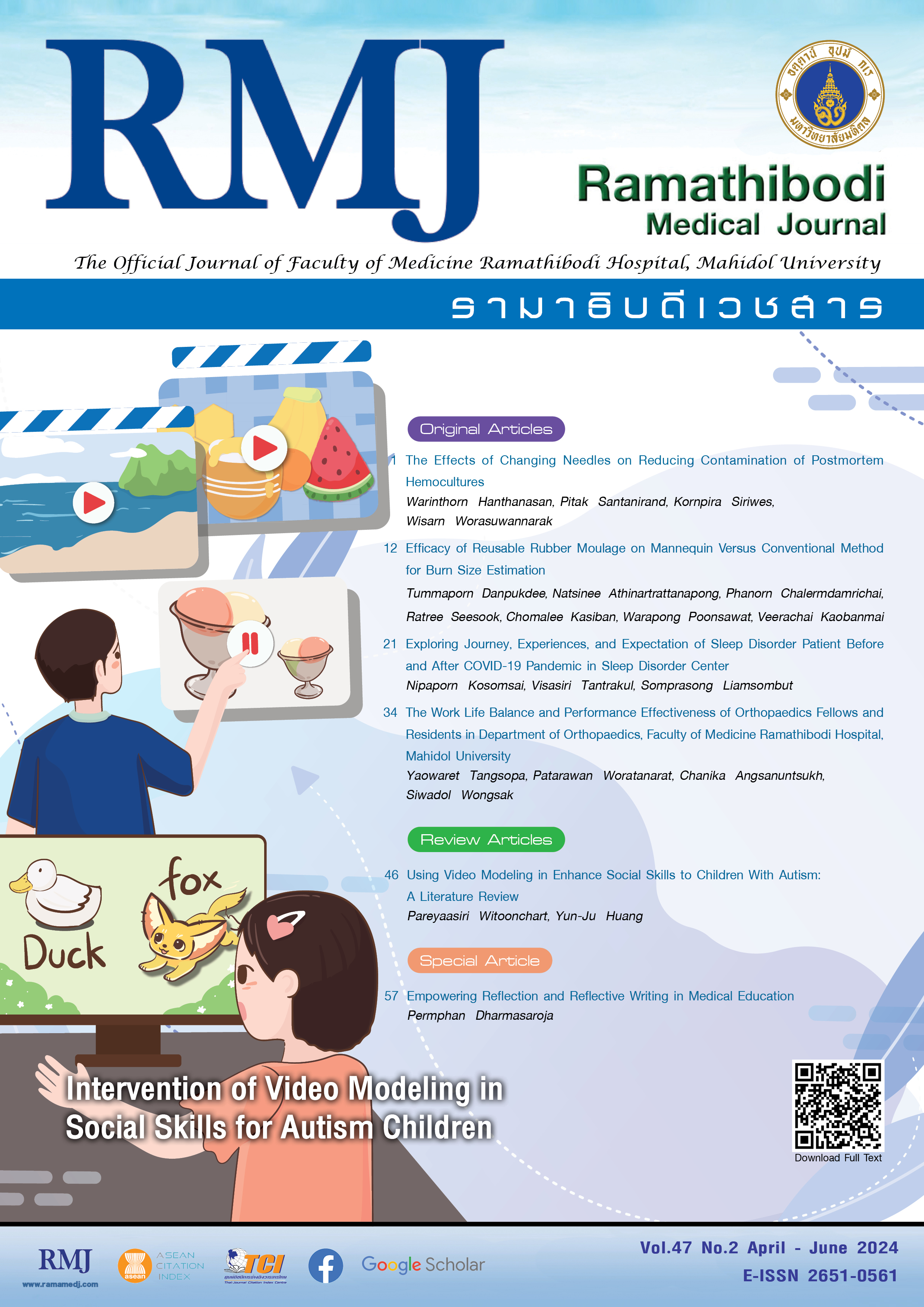Exploring Journey, Experiences, and Expectation of Sleep Disorder Patient Before and After COVID-19 Pandemic in Sleep Disorder Center
DOI:
https://doi.org/10.33165/rmj.2024.47.2.267867Keywords:
COVID-19, Polysomnography, Exploring journey, Experiences, ExpectationAbstract
Background: The COVID-19 pandemic has globally affected society, health, and the economy, leading to changes in the delivery of patient services, particularly in sleep disorder centers.
Objectives: To explore the pathways, experiences, and expectations of patients who underwent sleep disorder evaluations before and after the COVID-19 outbreak.
Methods: A qualitative ethnographic study was conducted, employing in-depth interviews with 20 patients from the Department of Medicine who has previously undergone sleep studies at the sleep disorders center at least once, before March 20, 2020. These patients had a follow-up sleep study appointment for their second visit between March 1, 2022, and December 31, 2022. The data were analyzed using thematic analysis principles.
Results: The pathways of patients undergoing sleep disorder evaluations changed at certain service points after the COVID-19 outbreak. One significant change was the increased waiting time for evaluations (average of 9 months and 12 days) compared to the period before COVID-19 (average of 3 months and 27 days). Additionally, patient satisfaction increased significantly (85.22% compared to 78.17%) due to changes of services into touchless technology and the implementation of telemedicine. Five factors remain to develop for better patient experience: 1) procedures, documents, and appointment queues; 2) communication channels; 3) tools, equipment, and environment; 4) benefits and others, and 5) staff.
Conclusions: Based on the research findings, recommendations for improving crisis planning in sleep disorder centers include reducing waiting times, providing continuous staff training, and integrating technology.
References
Department of Disease Control. Ministry of Public Health. Health Emergency Response Staff Handbook for the COVID-19 Outbreak in Thailand. March 26, 2020. Accessed February 20, 2024. https://ddc.moph.go.th/viralpneumonia/
Department of Disease Control. Ministry of Public Health. Occupational Health Guidelines for the Prevention and Management of Healthcare Workers Exposed to Novel Coronavirus Disease 2019 (COVID-19) in Hospitals. March 1, 2021. Accessed February 20, 2024. https://ddc.moph.go.th/viralpneumonia/g_km.php
Mahidol University. Announcement of Mahidol University on Teaching Guideline and Routine Work During the State of Emergency in Bangkok: Announced on the 18th October 2020. Published October 18, 2020. Accessed February 20, 2024. https://mahidol.ac.th/2020/announcement-18-10-63/
Ramathibodi Sleep Disorders Center, Faculty of Medicine Ramathibodi Hospital, Mahidol University. Suspension of Sleep Disorders Center Patient Services; 2020. March 19, 2020. Accessed June 1, 2023. https://www.rama.mahidol.ac.th/sleep_disorders/
Haraden C, Resar R. Patient flow in hospitals: understanding and controlling it better. Front Health Serv Manage. 2004;20(4):3-15.
Litvak E, ed. Managing Patient Flow in Hospitals: Strategies and Solutions. 2nd ed. Joint Commission Resources, Inc; 2010. Accessed February 20, 2024. https://store.jointcommissioninternational.org/assets/3/14/MPF09_Sample_Chapter.pdf
The Health Foundation. Improving Patient Flow. Learning Report. The Health Foundation; 2013.
Ford RC, Fottler MD. Creating customer-focused health care organizations. Health Care Manage Rev. 2000;25(4):18-33. doi:10.1097/00004010-200010000-00003
Thorne SE, Paterson BL. Two decades of insider research: what we know and don’t know about chronic illness experience. Annu Rev Nurs Res. 2000;18:3-25.
Iedema RA, Angell B. What are patients’ care experience priorities? BMJ Qual Saf. 2015;24(6):356-359. doi:10.1136/bmjqs-2015-004298
Ben-Tovim DI, Dougherty ML, O'Connell TJ, McGrath KM. Patient journeys: the process of clinical redesign. Med J Aust. 2008;188(S6):S14-S17. doi:10.5694/j.1326-5377.2008.tb01668.x
Samaranayake P, Dadich A, Fitzgerald A, Zeitz K. Developing an evaluation framework for clinical redesign programs: lessons learnt. J Health Organ Manag. 2016;30(6):950-970. doi:10.1108/JHOM-07-2015-0109
Trbovich P, Vincent C. From incident reporting to the analysis of the patient journey. BMJ Qual Saf. 2019;28(3):169-171. doi:10.1136/bmjqs-2018-008485
Sibley M, Earwicker R, Huber JW. Making best use of patient experience. J Clin Nurs. 2018;27(23-24):4239-4241. doi:10.1111/jocn.14504
Sheard L, Peacock R, Marsh C, Lawton R. What’s the problem with patient experience feedback? A macro and micro understanding, based on findings from a three-site UK qualitative study. Health Expect. 2019;22(1):46-53. doi:10.1111/hex.12829
Thippayakraisorn S. Digital age’s customer journey, a new marketing quest. Panyapiwat Journal. 2018;10(2):294-302.
Flom J. The Value of Customer Journey Maps: A UX Designer’s Personal Journey. September 7, 2011. Accessed February 20, 2024. https://www.uxmatters.com/mt/archives/2011/09/the-value-of-customer-journey-maps-a-ux-designers-personal-journey.php
Department of Disease Control, Ministry of Public Health. Guidelines for Healthcare Workers (HCWs) with Exposure to Confirmed Cases of COVID-19. March 3, 2022. Accessed February 20, 2024. https://ddc.moph.go.th/viralpneumonia/eng/guideline_hcw.php
Ruttawongsa A, Ruttawongsa A. Development of a continuity-of-care system for COVID-19 patients. Academic Journal of Mahasarakham Provincial Public Health. 2023;7(13):68-81.
Department of Medical Services, Ministry of Public Health. Final Report: Data Survey and Needs Assessment of Stakeholders, Department of Medical Services; Fiscal Year 2020. NIDA Poll; 2021. Accessed February 20, 2024. https://dms.go.th/Content/Select_Content_Grid_PDF?contentCategoryId=10&grid-page=3&grid-sort=SetNumberContent-desc
Khotsanlee W. Service of quality for pregnant women in using obstetrics and gynecology clinic, one in Chiang Mai. Journal of Innovative Business Management Research. 2018;4(4):284-290.
Ou-ngern N, Visitnitikija C. Services quality development of Bangpakok 9 Hospital. Journal of Roi Et Rajabhat University. 2020;4(1):210-220.
Khamchai N. A Study of the Quality of Outpatient Services at Buriram Hospital. Buriram Province. Master’s Thesis. Buriram Rajabhat University; 2010. Accessed February 11, 2024. http://dspace.bru.ac.th/xmlui/handle/123456789/1996
Thongyam P. The importance of service quality for business success. Kasem Bundit Journal. 2017;18(1):219-231.
Sangprapai N. Experience of professional nurses in caring for COVID-19 patients Banphraek Hospital. Journal of Health and Environmental Education. 2023;8(1):119-131.
Downloads
Published
How to Cite
Issue
Section
License
Copyright (c) 2024 By the Authors. Licensee RMJ, Faculty of Medicine Ramathibodi Hospital, Mahidol University, Bangkok, Thailand

This work is licensed under a Creative Commons Attribution-NonCommercial-NoDerivatives 4.0 International License.

















